ClickUp is a flexible project management platform designed to keep everything streamlined in one place. It’s a great system for teams looking to track and organize their work efficiently.
You may find yourself already using ClickUp and seeking something more robust to handle more complex projects, or wondering if ClickUp is the platform you should use to begin your work management journey. While ClickUp is a great solution, it’s not the only one out there, and it certainly isn’t the right choice for every type of team or unique project need.
This blog post will give you some ClickUp alternatives to consider while shopping around for a new work management platform and look at why monday work management is such a popular option.
Get startedWhat is ClickUp?
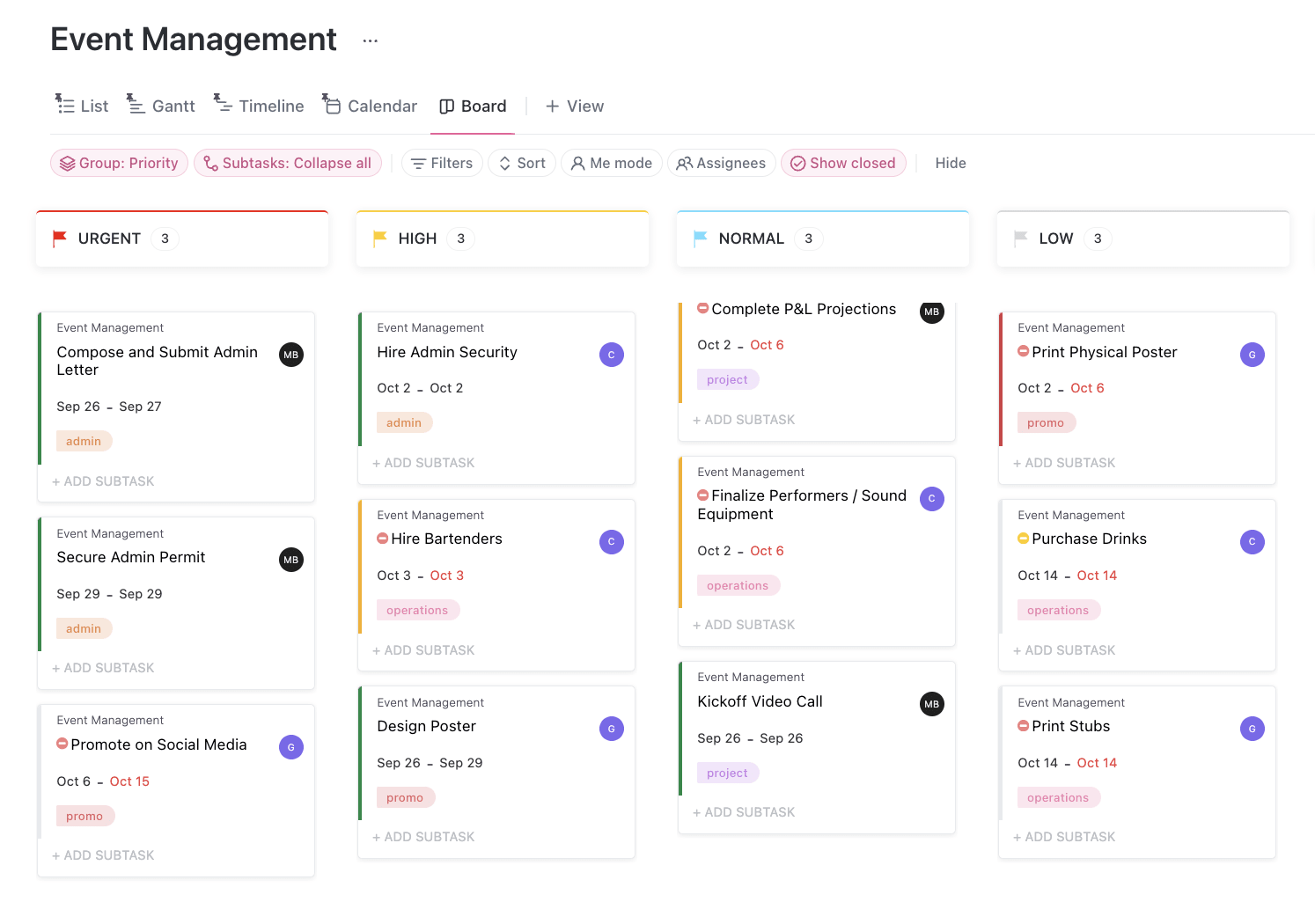
ClickUp is a work management platform that brings teams, projects, and workflows all into one place. As a customizable and versatile platform, ClickUp allows in-house, hybrid, and remote teams to work their way, while creating unique workflows and automations that match their needs.
As a work management solution, ClickUp can fit many use cases, not just project management, but also the workflows of marketing, product, engineering teams, and more. Some of ClickUp’s core features include:
- Whiteboards to visually collaborate and turn complex projects into actionable tasks
- Set and track goals with clear timelines, targets, and automatic progress-tracking
- Connect with your team in real-time with a built-in chat feature
- Custom templates help your business get started on projects right away
- Add even more functionality to the platform with ClickApps and 1,000+ integrations
Why you may need a ClickUp alternative
While ClickUp can cater to diverse organizational needs, it may not be the number-one solution for every team or company. There are many work and project management tools on the market, some of which are more targeted to specific industries, while others can match diverse work needs.
- Overwhelming user interface: Despite ClickUp’s feature-rich offering, some teams require a more straightforward, intuitive interface with fewer options.
- Specific feature requirements: Depending on your workflow, you may need additional features like recurring tasks or more advanced functionality.
- Performance and reliability issues: Some users have reported problems like disappearing items, interface breakdowns when renaming items, and hard-coded properties that can’t be edited.
- Pricing: ClickUp’s pricing structure may not be ideal for some organizations.
When considering alternatives, it’s important to define your specific goals and work management requirements to find the best fit for your team or organization.
The best ClickUp alternatives at a glance
Below, we’ve compared the top 10 ClickUp alternatives so you can see all your options in one place.
| Best for | Standout feature | Pricing | |
|---|---|---|---|
| monday work management | Teams seeking a visual, collaborative, and customizable project management solution | Visual and customizable interface for managing projects and workflows | Premium plans from $9 per user per month |
| Wrike | Teams who need a comprehensive project management solution with advanced planning, tracking, and reporting features | Visual dashboards for planning and allocating project resources | Free plan available; premium plans from $9.80 per user per month |
| Asana | Teams who want a user-friendly and flexible task management platform for collaboration | Intuitive and flexible interface | Free plan available; premium plans from $10.99 per user per month |
| Hive | Teams who want a centralized workspace for communication and streamlining workflows | Centralized collaboration | Free plan available; premium plans from $5 per user per month |
| Trello | Teams who prefer a visual project management tool with a Kanban approach | Kanban-style project management | Free plan available; premium plans from $5 per user per month |
| Basecamp | Teams prioritizing ease of use and simplicity in a straightforward solution | Communication and collaboration | Premium plans from $15 per user per month |
| Jira | Teams that need to manage IT issues and software development bugs | Agile project management and issue-tracking | Free plan available; premium plans from $8.15 per user per month |
| Airtable | Teams seeking a platform that combines spreadsheets with centralized databases | Highly customizable data management | Free plan available; premium plans from $20 per user per month |
| Notion | Teams looking for a platform to help with collaborative note-taking and creating a knowledge base | Combination of databases, documents, and workflows | Free plan available; premium plans from $8 per user per month |
| Nifty | Teams who want to optimize project workflows on a customizable and visual platform | Centralized collaboration | Premium plans from $7 per user per month |
1. monday work management
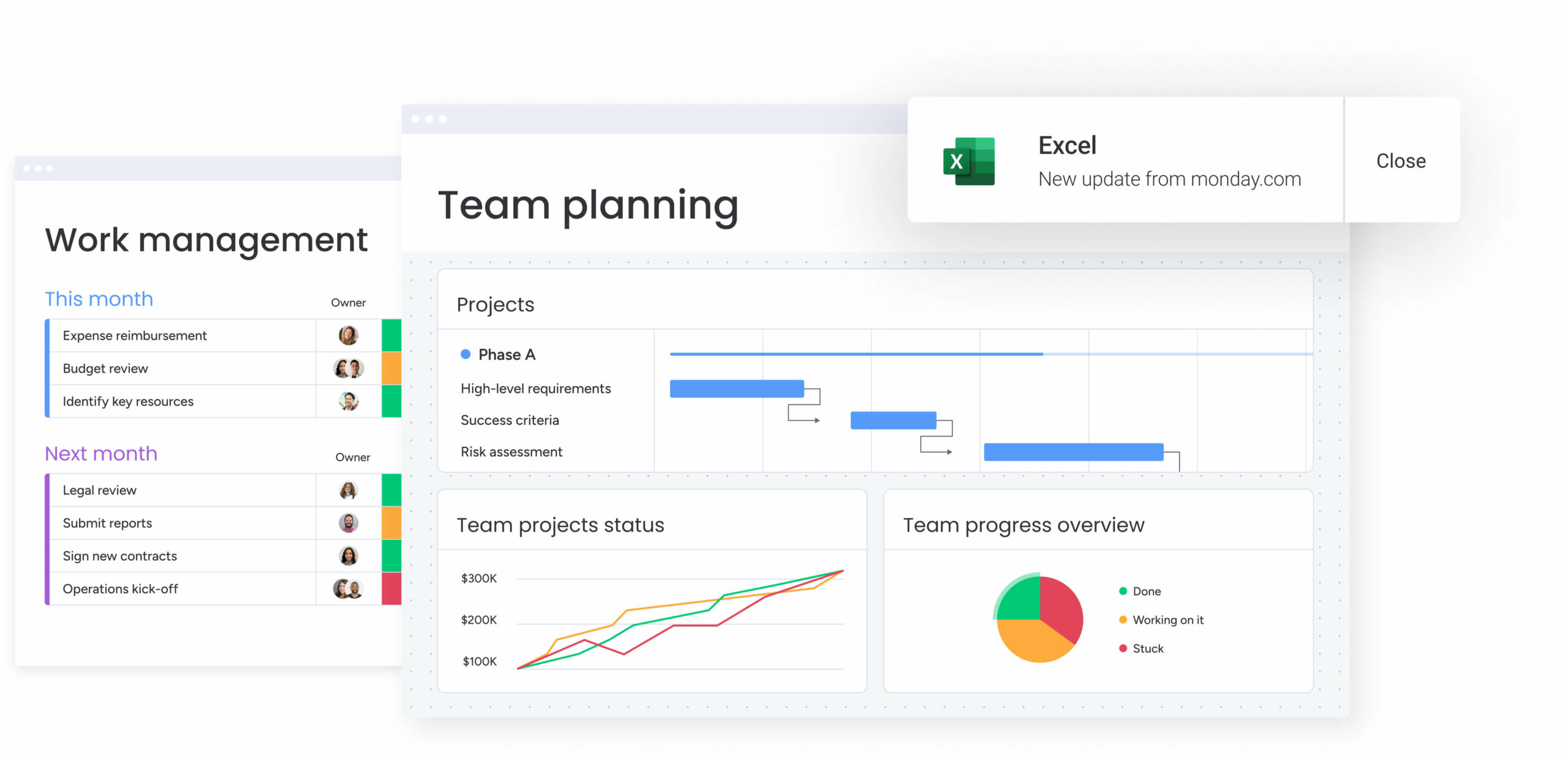
Best for: A diverse range of teams seeking a visual, collaborative, and customizable project management solution
Built on monday.com Work OS, monday work management is a flexible and versatile system that can fit any industry or need. With monday work management, you can collaborate and communicate simply in one place, facilitating project management from essential deliverables to small tasks. It helps in-house, hybrid, and remote teams streamline task management, fine-tune project planning, and keep documents and important files organized in one centralized hub. Not only that, but the platform is entirely scalable to fit the needs of any team, from a one-person show to large enterprises.
monday work management key features
- Manage unlimited projects on a visual and customizable interface with 27+ different work views
- Automate repetitive tasks and processes to enhance efficiency and set task reminders so nothing falls through the cracks
- Collaborate seamlessly with real-time updates, comments, and file sharing
- 200+ integrations allowing you to keep using your existing work tools without disruption
- View your team’s workload to manage even distribution of project tasks
monday work management pros
- Improves efficiency and productivity
- Offers best-in-class 24/7 customer support
- Includes an excellent mobile app for on-the-go project management
monday work management cons
- Premium plans have a three-user minimum
- Certain advanced features are only available on higher plans
monday work management pricing
Start with a 14-day free trial (no credit card required) and then choose from four premium plans:
- Basic: $9/seat/month for managing all your team’s work in one place.
- Standard: $12/seat/month for collaborating and optimizing your work across teams.
- Pro: $19/seat/month for companies wishing to streamline complex workflows at scales.
- Enterprise: Custom quote for larger organizations wanting enterprise-grade security and controls.
Learn more about monday work management pricing to find out which plan is best for you.
monday work management review ratings
- G2: 4.7 out of 5
- Capterra: 4.6 out of 5 — “monday.com is the best way for teams to organize!”
- TrustRadius: 8.4 out of 10
Compare: monday.com vs. ClickUp, monday.com vs. Asana, monday.com vs. Jira, monday.com vs. Trello, monday.com vs. Smartsheet
Get started2. Wrike
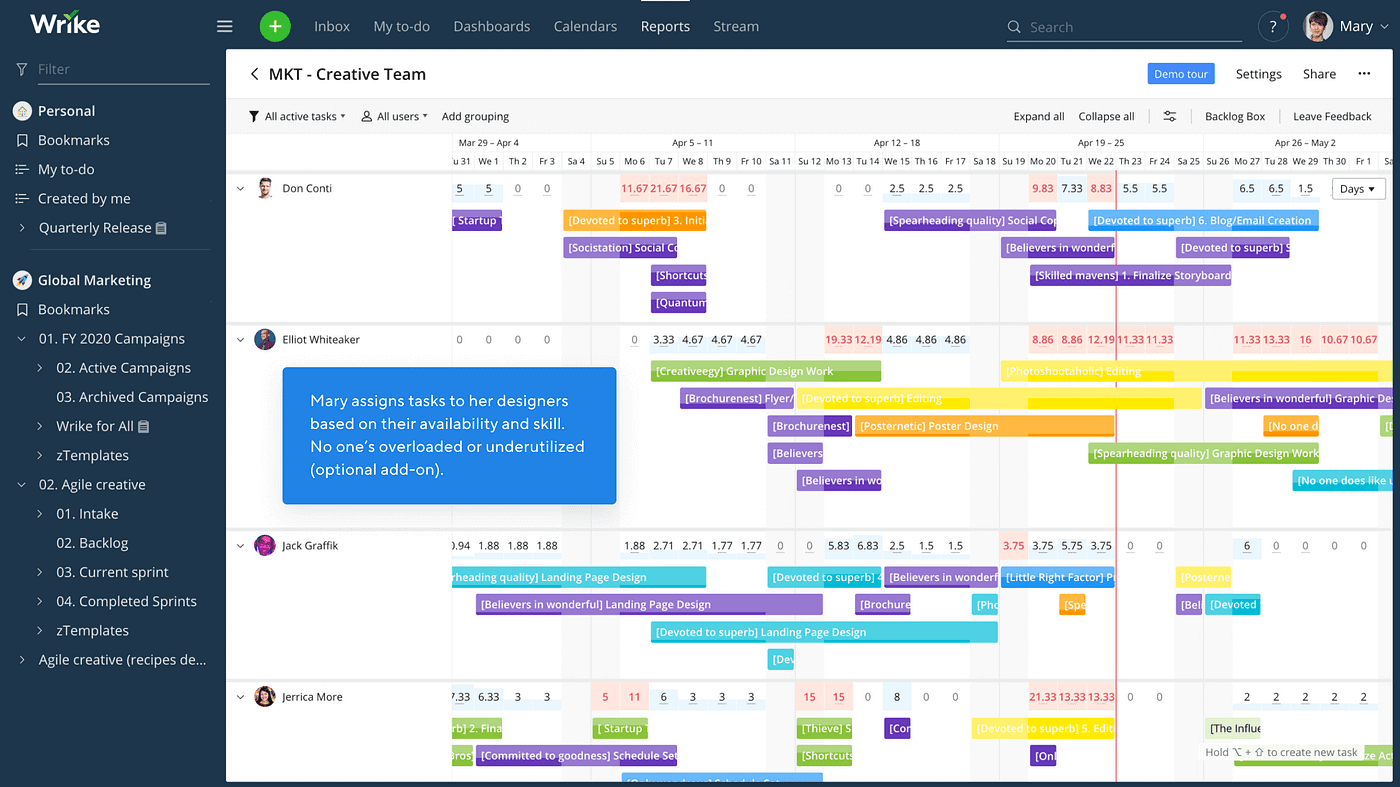
Best for: Teams who need a comprehensive project management solution with advanced planning, tracking, and reporting features
A robust project management platform, Wrike makes it simple for teams to track tasks and communication in one centralized space. With task management software for following tasks, time tracking, detailed reporting, and automating workflows, Wrike is a comprehensive and flexible option for teams of all sizes.
Wrike key features
- Plan and allocate project resources in visual dashboards
- Integrate with 400+ popular work apps like Slack, HubSpot, Facebook Ads, Google Apps, and more
- Generate detailed reports to gain insights into project performance and see where to improve
Wrike pros
- Offers numerous customization options
- Utilizes AI to create insights
Wrike cons
- Some users, especially newcomers, may find the interface confusing and overwhelming
- The free plan only includes basic features
Wrike pricing
- Free: Suitable for teams getting started.
- Team: $9.80/user/month (billed annually) suits growing teams of 3-25 people.
- Business: $24.80/user/month (billed annually) for all teams across an organization.
- Enterprise: Custom pricing on the enterprise plan for large teams requiring enterprise-grade security and scalability.
- Pinnacle: Custom pricing for teams with complex work needs.
Read more about Wrike’s plans and pricing.
Wrike review ratings
- G2: 4.2 out of 5
- Capterra: 4.3 out of 5 — “So far, Wrike has been fantastic helping us transition to a more natural workflow.”
- TrustRadius: 8.2 out of 10
Compare: Wrike vs. monday.com, Wrike vs. Asana, Wrike vs. Basecamp, Wrike vs. Jira, Wrike vs. Smartsheet, Wrike vs. Trello, Wrike Review
3. Asana
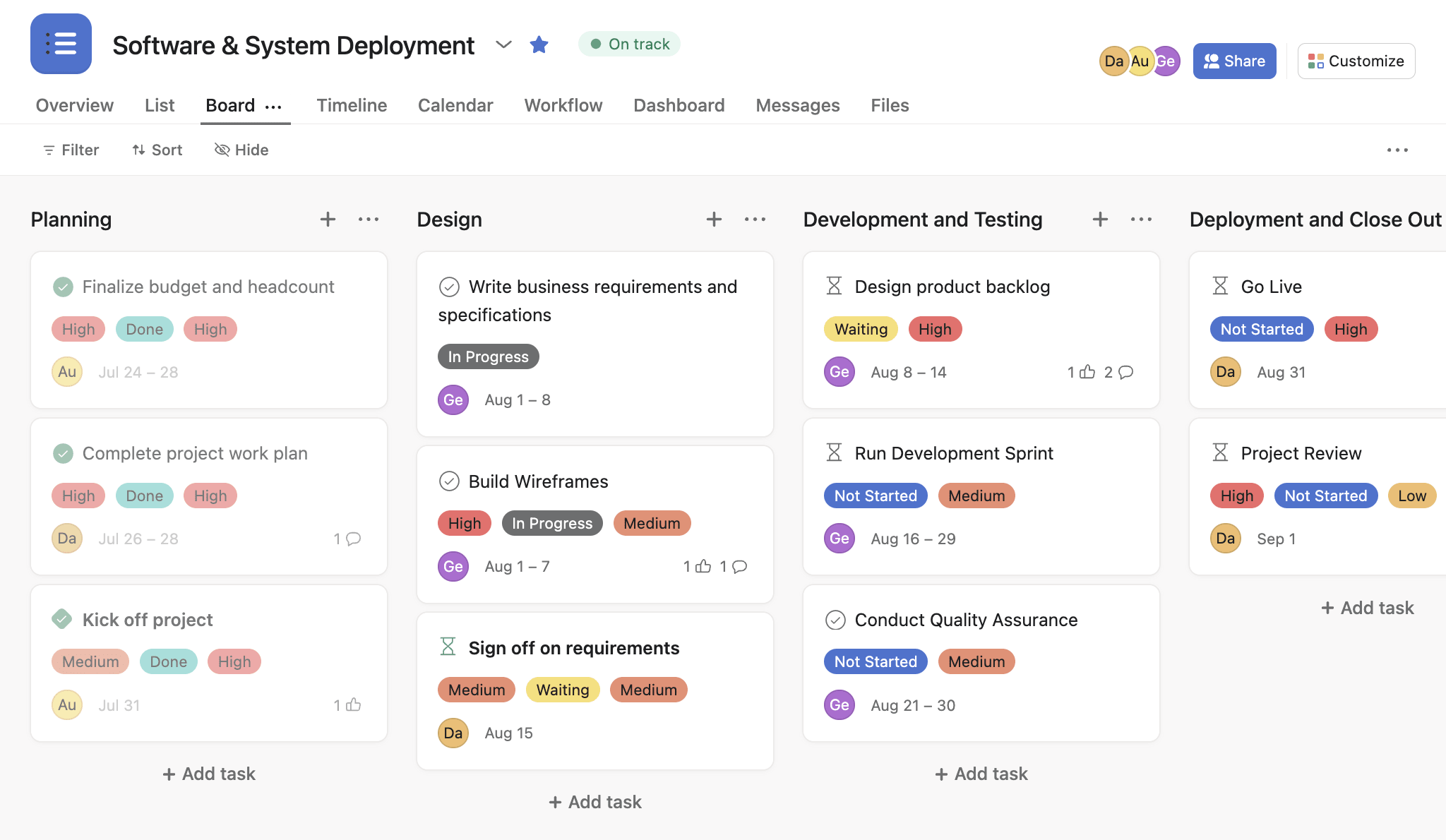
Best for: Companies who want a user-friendly and flexible task management platform for collaboration
Asana is a widely used task and management platform designed to help teams organize and prioritize projects. The platform is easy to use and offers straightforward collaboration features that help teams work together towards their goals.
Asana key features
- Get real-time insights into your projects with reporting tools
- Choose from multiple project views, including boards, lists, and timelines
- Build automations for project updates, communications, or task reminders
Asana pros
- User-friendly, straightforward, and intuitive to use
- Enhances collaboration among team members
Asana cons
- Steep learning curve for new users
- Only one person can be assigned per task
- The Basic plan is missing a lot of essential features
Asana pricing
- Personal: Free for individuals or small teams looking to manage tasks.
- Starter: $10.99/user/month (billed annually) for growing teams that need to track project progress.
- Advanced: $24.99/user/month (billed annually) for companies that need to manage unlimited projects across teams.
- Enterprise tiers: Custom pricing for larger companies that need to automate complex work across departments.
Read more about Asana’s plans and pricing.
Asana review ratings
- G2: 4.4 out of 5
- Capterra: 4.5 out of 5 — “Great software for multiple teams.”
- TrustRadius: 8.4 out of 10
Compare: Asana vs. monday.com, Asana vs. Notion, Asana vs. Airtable, Asana vs. Trello, Asana vs. Jira, Asana Alternatives
4. Hive
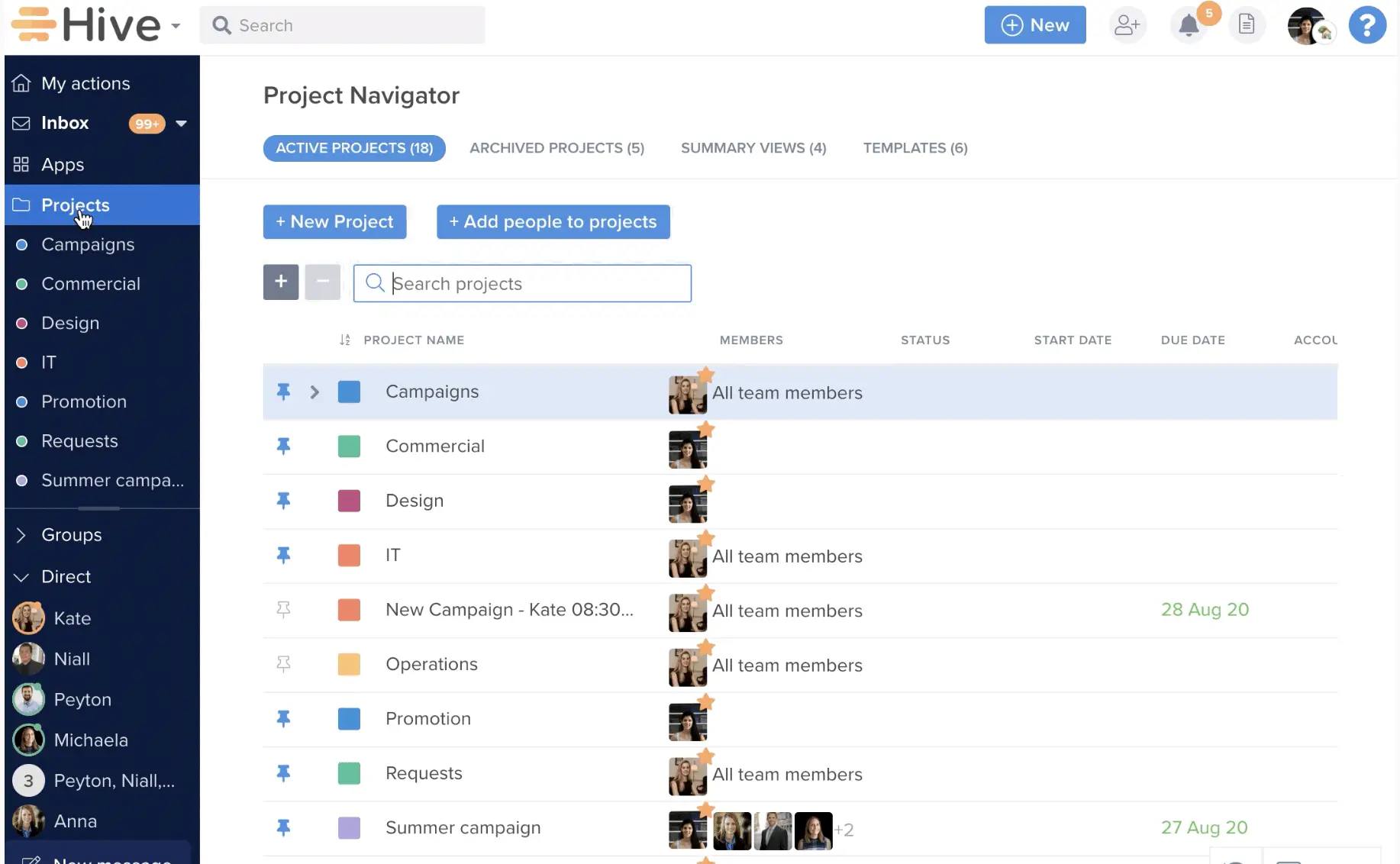
Best for: Teams who want a centralized workspace for communication and streamlining workflows
Hive is a powerful productivity platform that helps teams manage projects, collaborate efficiently, and centralize multiple productivity tools in one place. As a team collaboration platform, Hive focuses on increasing team productivity by providing a unified and visual workspace for communication and multi-step project execution.
Hive key features
- Set project goals to create a sense of purpose and visualize and track their progress
- Host interactive meetings by connecting to video and taking notes to map out an agenda
- Seamlessly connect with over 1,000 popular apps like Slack, Google Drive, and Zoom
Hive pros
- Users can personalize their workspace to fit their needs and preferences
- Provides detailed insights into team performance and project progress
Hive cons
- Limited number of integrations available
- Limited mobile app functionality compared to the desktop version
- Limited features for expense tracking
Hive pricing
- Free: For light project management tasks of small teams up to 10.
- Starter: $5/user/month (billed annually) for entry-level project management.
- Teams: $12/user/month (billed annually) for unlimited workspace members and customization.
- Enterprise: Custom pricing for larger teams requiring more flexibility, extra support, and security.
Hive review ratings
- G2: 4.6 out of 5
- Capterra: 4.5 out of 5 — “Seamless use among the team that definitely improves overall efficiency and effectiveness.”
- TrustRadius: 8.4 out of 10
5. Trello
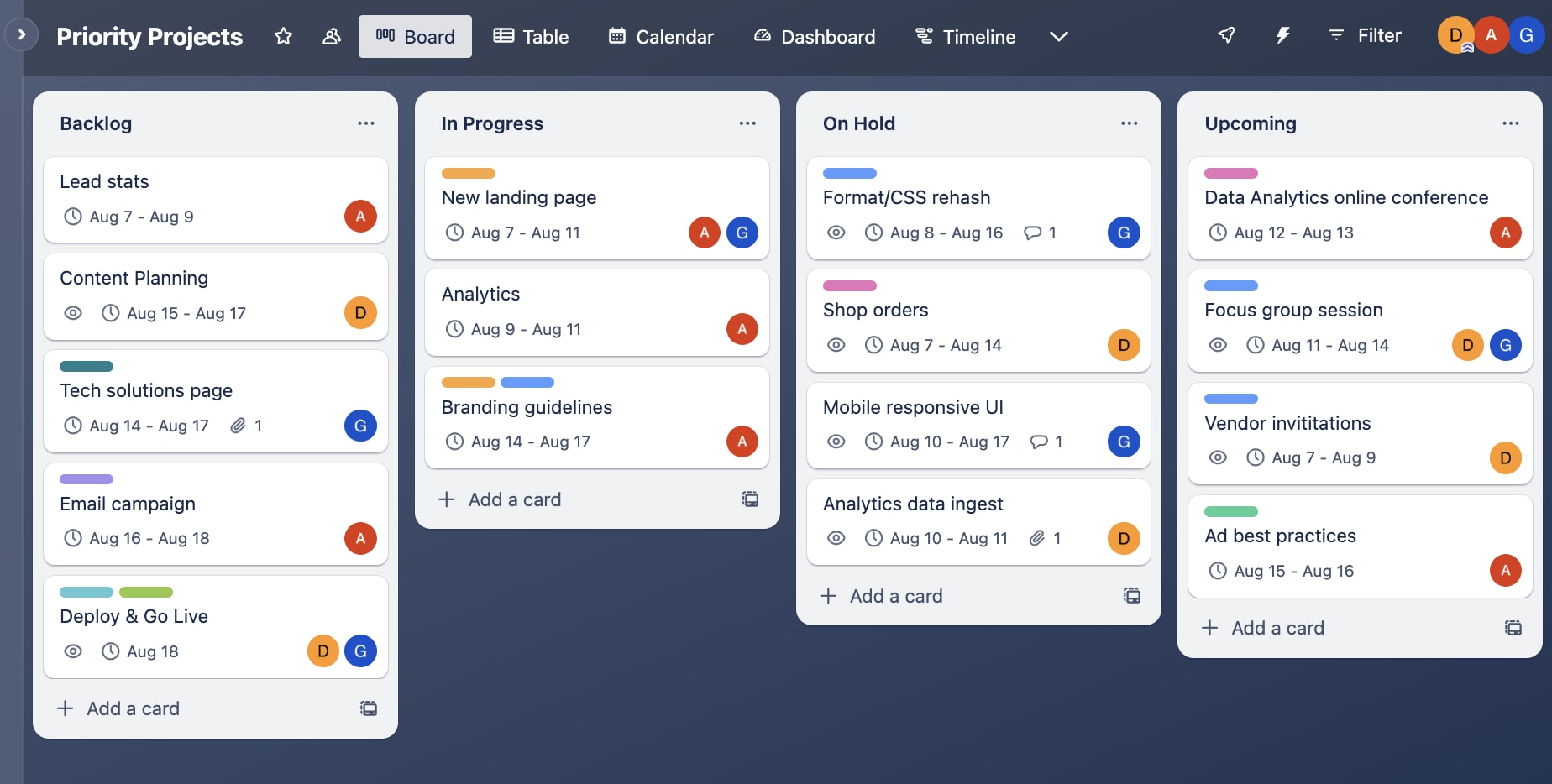
Best for: Those who prefer a visual task management tool with a Kanban approach
Trello is a popular visual platform that reflects a Kanban-style approach, relying on cards and boards to help teams plan and execute projects. Trello is easy to use and can be tailored to different teams and use cases. The cards, representing tasks, are customizable and can be adjusted to include attachments, categories and labels, checklists, and more.
Trello key features
- Multiple work views aside from Kanban, including calendars, timelines, tables, and others
- Create custom workflows through Trello’s Butler to automate repetitive tasks
- Boost functionality by integrating Power-Ups, or integrations, for additional features
Trello pros
- Intuitive and easy to use, with a straightforward dashboard
- Teams can collaborate and communicate in real-time
Trello cons
- Lacks some advanced project management tools like time tracking and Gantt charts
- Kanban-style approach may not suit larger, complex, and unpredictable projects
Trello pricing
- Free: For individuals or teams looking to organize any project with essential features.
- Standard: $5/user/month (billed annually) for small teams that need to collaborate and manage work.
- Premium: $10/user/month (billed annually) for teams that need to track and visualize work with multiple views.
- Enterprise: $17.50/user/month (billed annually) for organizations that need more security and controls across teams.
Read more about Trello’s plans and pricing.
Trello review ratings
- G2: 4.4 out of 5
- Capterra: 4.5 out of 5 — “User-friendly interface makes this software not only extremely effective, but also visually pleasing.”
- TrustRadius: 8.0 out of 10
Compare: Trello vs. ClickUp, Trello vs. monday.com, Trello vs. Notion, Trello vs. Asana, Trello vs. Airtable
6. Basecamp
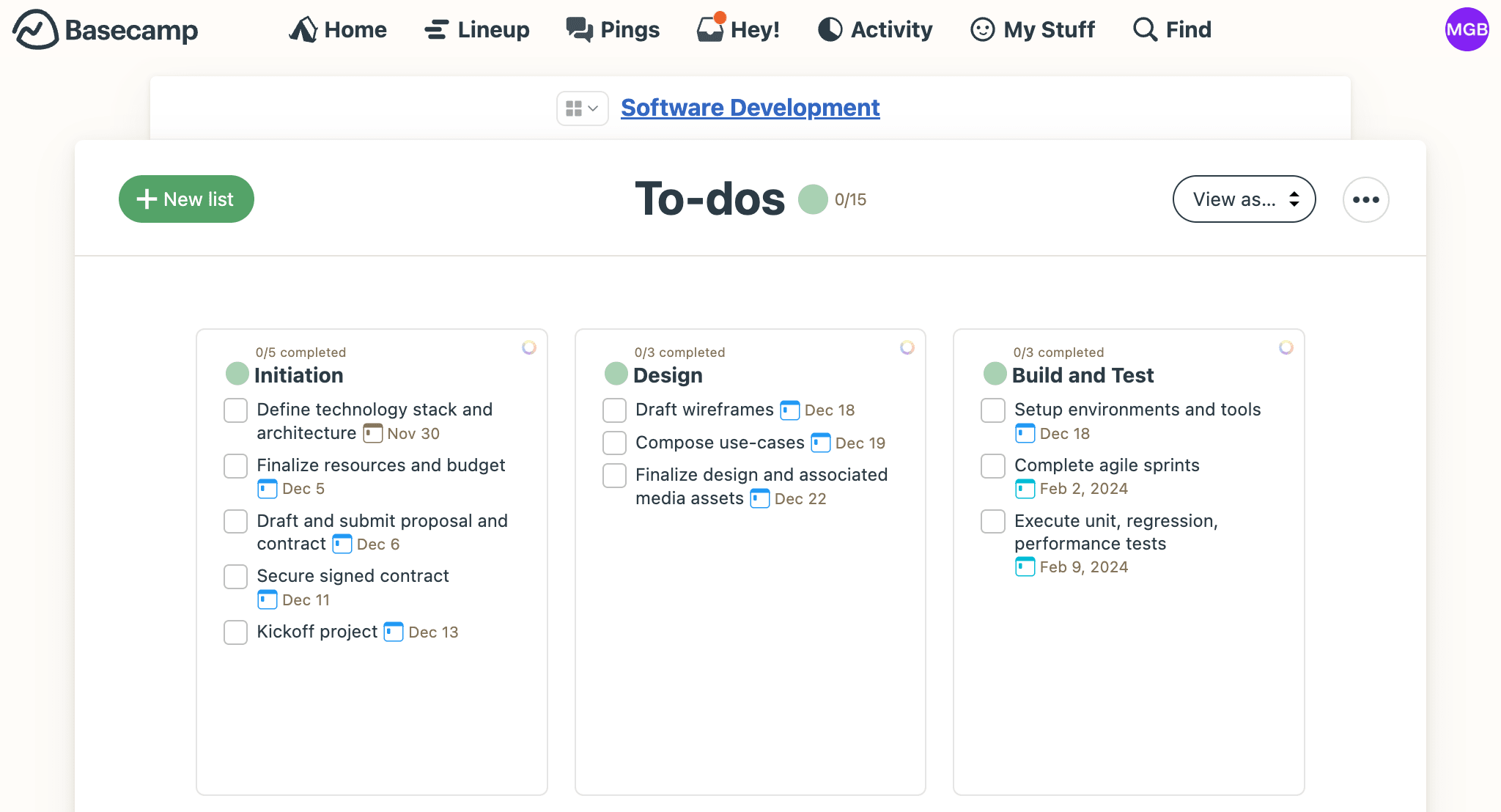
Best for: Teams prioritizing ease of use and simplicity in a straightforward solution
Basecamp’s project management platform offers a simplified space for project management and team collaboration. Featuring an intuitive interface and handy features for storing files and documents, communicating between team members, and work collaboration tools, Basecamp is a great option for small to medium-sized teams looking for a straightforward work management solution.
Basecamp key features
- Communicate in real-time with chats, a built-in commenting system, and messages where you can share files and updates
- Create to-do lists with tasks, subtasks, responsibilities, and due dates
- Automated check-ins remind team members to share regular updates on their tasks
Basecamp pros
- Combines project management, file storage, and team communication features in one platform
- Is used by software development teams for agile and scrum planning
- Ideal for real-time updates via the message board
Basecamp cons
- Lacks some advanced project management tools like time tracking and cross-project views
- Some users report difficulties learning how to best utilize all its features
Basecamp pricing
- Basecamp: $15/user/month (billed monthly) for freelancers, startups, or smaller teams who want to pay month-to-month.
- Basecamp Pro: $299/month (billed annually) for larger teams and companies who want one flat fee for unlimited users.
Read more about Basecamp’s plans and pricing.
Basecamp review ratings
- G2: 4.1 out of 5 — “Great collaborative project management platform for teams.”
- Capterra: 4.3 out of 5
- TrustRadius: 8.0 out of 10
Compare: Basecamp vs. Jira, Basecamp vs. Asana, Basecamp vs. Wrike, Basecamp vs. Teamwork, Basecamp Alternatives
7. Jira
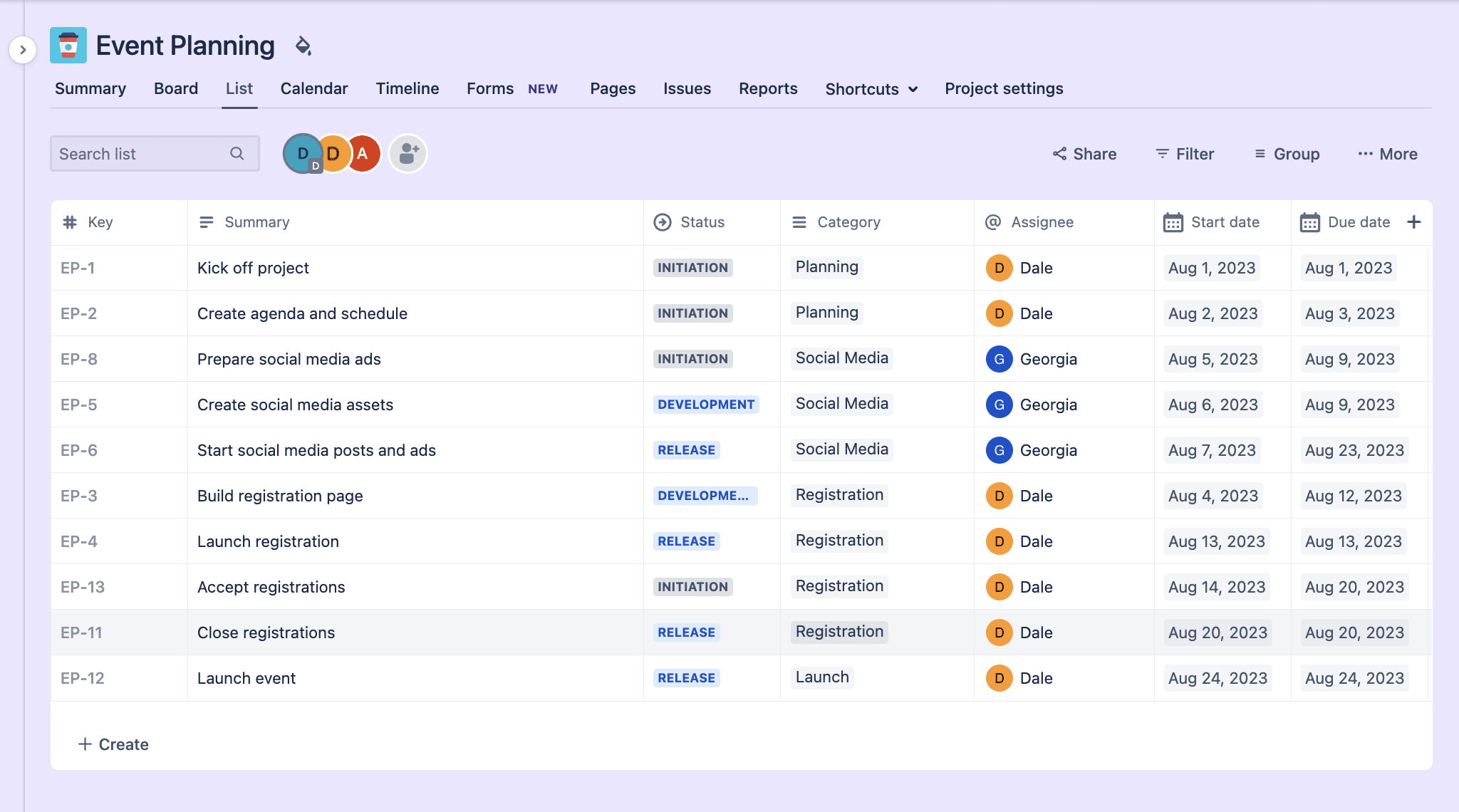
Best for: Software development and IT teams looking for a way to manage issues and bugs
Jira, developed by Atlassian, is an Agile project management and issue-tracking solution. While often used by software developers, it can still be applied to other departments and use cases. Jira helps teams build custom workflows, track issues and bugs, and collaborate easily with team members.
Jira key features
- Plan, track, and release software and projects using Agile boards and other work views like Scrum and timelines
- Connect to over 2,000 different integrations on the Atlassian marketplace
- Robust reporting and insights tools on projects and sprints come out of the box
Jira pros
- Excellent issue management and bug tracking
- Highly customizable for Agile methodologies
Jira cons
- Complex interface with a steep learning curve
- Slow loading times can affect overall efficiency and performance
Jira pricing
- Free: For teams of up to 10 users.
- Standard: $8.15/user/month includes everything you need to get started.
- Premium: $16/user/month for connecting multiple teams.
- Enterprise: Custom pricing for advanced analytics and security for enterprises.
Read more about Jira’s plans and pricing.
Jira review ratings
- G2: 4.3 out of 5
- Capterra: 4.4 out of 5 — “Jira is excellent as a collaborative ticketing and software development project management tool.”
- TrustRadius: 8.1 out of 10
Compare: Jira vs. ClickUp, Jira vs. Asana, Jira vs. Basecamp, Jira vs. monday.com, Jira Alternatives
8. Airtable

Best for: Teams seeking a platform that combines spreadsheets with centralized databases
Airtable is a project management platform combining spreadsheets and databases, targeted specifically towards app development teams. That said, Airtable can still be used by all kinds of in-house, hybrid, and remote teams as it offers a flexible platform ideal for collaboration and visually organizing important work information.
Airtable key features
- Create a custom database to visualize workflows, create custom fields, and get insights from your data
- Build apps quickly with ready-to-go templates for planning products, production, and more
- Generative AI tools within Airtable help you optimize workflows related to sales, marketing, and others
Airtable pros
- Real-time data accessibility
- Intuitive no-code/low-code app builder
Airtable cons
- Limited reporting capabilities compared to more advanced database software
- Significant learning curve, especially for those transitioning from traditional spreadsheets
Airtable pricing
- Free: For individuals and small teams just getting started.
- Team: $20/seat/month (billed annually) for teams building collaborative apps and workflows.
- Business: $45/seat/month (billed annually) for teams requiring more advanced features.
- Enterprise Scale: Custom pricing for larger organizations requiring robust governance.
Read more about Airtable’s plans and pricing.
Airtable review ratings
- G2: 4.6 out of 5 — “A flexible and versatile project management tool.”
- Capterra: 4.7 out of 5
- TrustRadius: 8.5 out of 10
Compare: Airtable alternatives, Airtable vs. Asana, Airtable vs. monday.com, Airtable vs. Trello, Airtable vs. Smartsheet
9. Notion
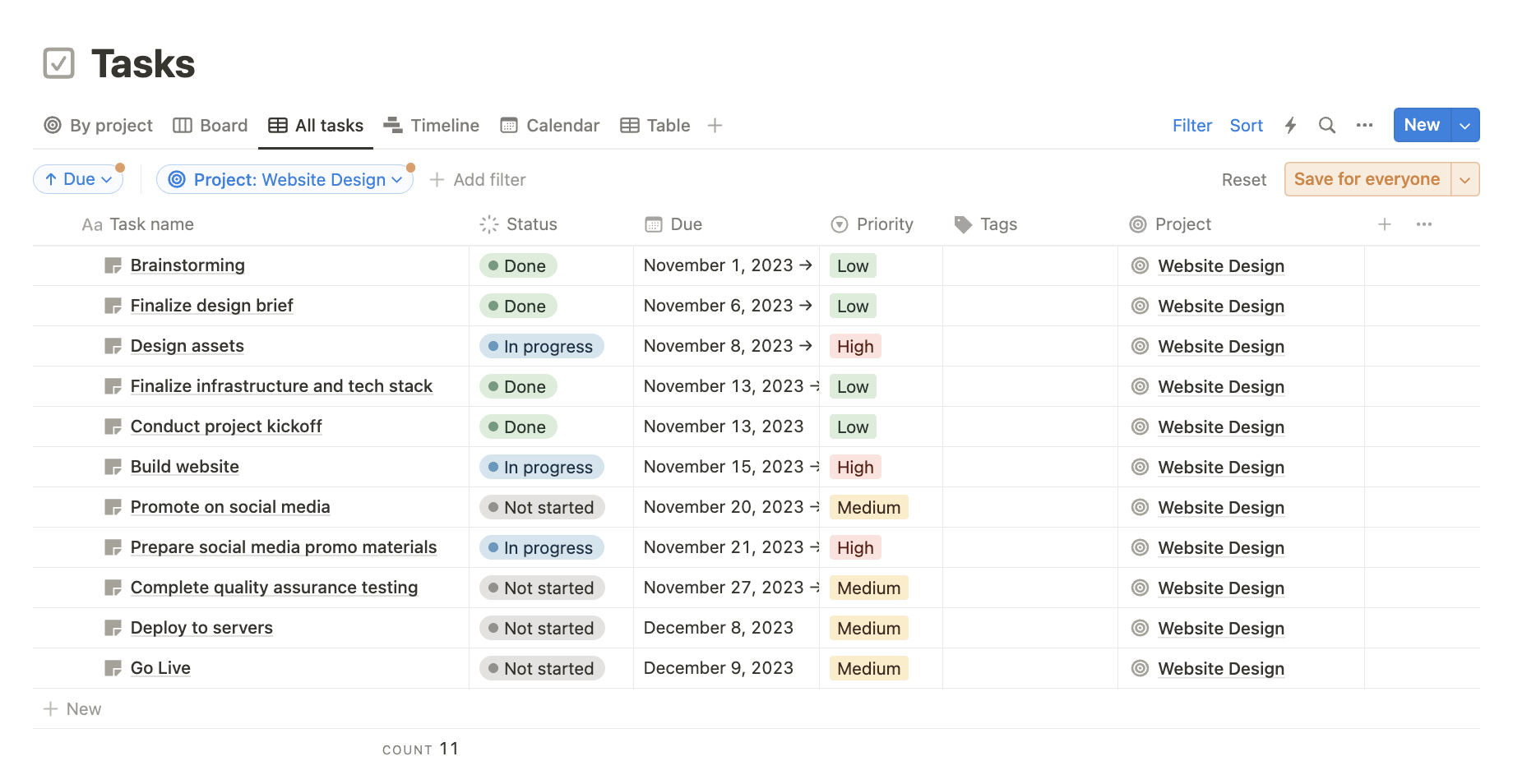
Best for: Teams looking for a platform to help with collaborative note-taking and creating a knowledge base
Bringing together multiple workflow capabilities, such as note-taking, task management, and collaboration tools, Notion makes for a simple and straightforward solution. It’s ideal for teams looking for a knowledge base for project stakeholders along with essential project and task management functionality.
Notion key features
- Take notes in meetings to keep projects on target and simplify task lists
- Collaboration in real-time on documents and add in all types of media
- Great featured for content creation for content writers and managers
- Integrated AI assistant helps teams autofill tables, write better, and ask questions to find important information
Notion pros
- Integrates with Trello, Slack, Google Drive, and more
- Ideal for teams to store essential information and collaborate efficiently
Notion cons
- Lacks project management features like time tracking and Gantt charts
- Managing multiple projects can be a tedious process
Notion pricing
- Free: For individuals wanting to get started with basic features.
- Plus: $8/user/month (billed annually) for small groups to plan and organize.
- Business: $15/user/month (billed annually) for companies wishing to connect several teams and tools.
- Enterprise: Custom pricing for larger organizations requiring advanced admin and security.
- Notion AI: Add to any paid plan for $8/user/month (billed annually).
Notion review ratings
- G2: 4.7 out of 5 — “Comprehensive tool with limitless application.”
- Capterra: 4.7 out of 5
- TrustRadius: 8.7 out of 10
Compare: Notion vs. Trello, Notion vs. monday.com, Notion vs. Asana, Notion alternatives
10. Nifty
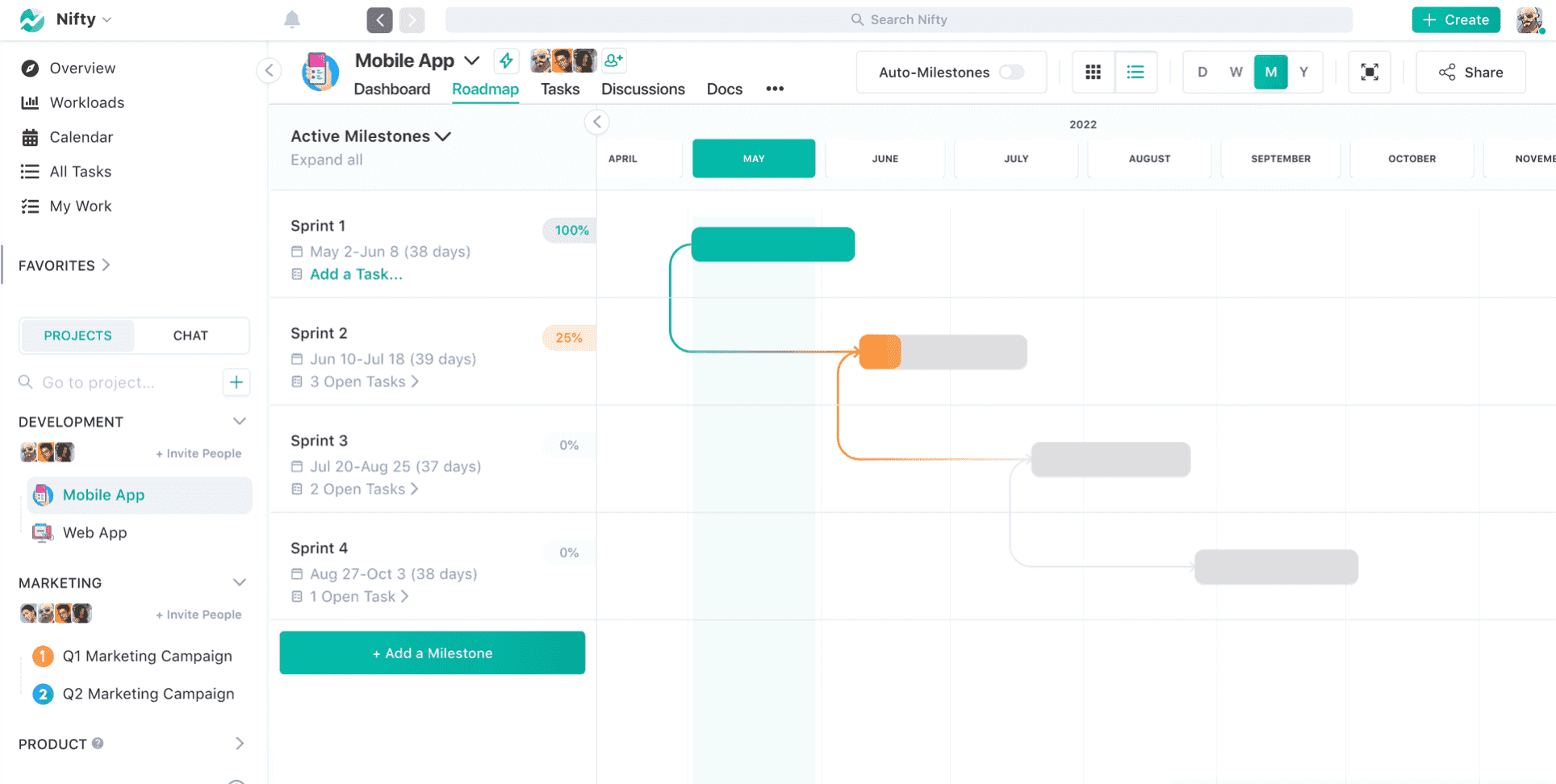
Best for: Teams who want to optimize project workflows on a customizable and visual platform
Nifty helps teams collaborate and focus multiple project workflow functionalities in one centralized system. With Nifty, teams can work together towards goals and on various project processes through roadmaps to align on goals, documents that can be shared and worked on in real-time, and forms to capture data.
Nifty key features
- Create visual timelines to establish objectives and plan out your project roadmap
- Automate reporting and project progress tracking across all tasks and teams
- Track time to improve productivity, budgeting, and balance workloads
Nifty pros
- Creates project portfolios based on operations, account ownership, client delivery, and more
- Helps teams make more accurate time estimates for future projects
Nifty cons
- Limited customization options compared to other project management software
- Lacks some of the advanced features that larger teams or more complex projects may require
Nifty pricing
- Free: Includes basic features to get started.
- Personal: $7/user/month (billed annually) includes all essential features.
- Pro: $10/user/month (billed annually) includes all enhanced features.
- Business: $16/user/month (billed annually) for advanced workflows.
- Enterprise: Custom pricing for large-scale organizations.
Nifty review ratings
- G2: 4.7 out of 5 — “Amazing tool and easy to use.”
- Capterra: 4.6 out of 5
- TrustRadius: 10 out of 10
Why monday.com is the best ClickUp alternative
As you can see, there are many great ClickUp alternatives on the market. ClickUp itself is a good option, but if you’re looking for a highly customizable platform for any size team that’s easy to use and adapts to your unique workflows, consider monday work management
Get startedHere’s what differentiates monday work management from ClickUp and its competitors.
Ease of use
While monday work management offers a wide range of features, nothing ever feels overwhelming. Every board, view, and widget works just as you’d expect, so you don’t lose precious work hours when setting things up. As one user puts it: “I have yet to see any other tool that offers the quantity and quality of features that monday work management does.”
On review sites like G2, users consistently rate monday.com as more user-friendly and intuitive than ClickUp. It has a cleaner, less cluttered interface that is easier to navigate, especially for beginners. Compared to ClickUp, reviewers found monday.com easier to use, set up, and administer with excellent customer support.
| ClickUp | monday.com | |
|---|---|---|
| Ease of use | 8.5 | 9.1 |
| Ease of setup | 8.2 | 8.8 |
| Ease of admin | 8.6 | 9.1 |
| Quality of support | 8.9 | 9.0 |
Customizable workflows and automation
While both offer customization and automation features, users praise monday.com for being more intuitive and flexible. You can build the perfect view of your workflow with over 10 drag-and-drop widgets. Plus, you can save valuable time with its automated workflows and 200+ templates.

As Diogo B noted: “The customizable workflows and automation features save us so much time, allowing us to focus on what really matters.”
Quick integrations
Both ClickUp and monday work management are powerful tools that offer a wide range of integrations with popular third-party tools and services, including Google Workspace, Microsoft 365, Slack, Zoom, Salesforce, GitHub, and Dropbox.
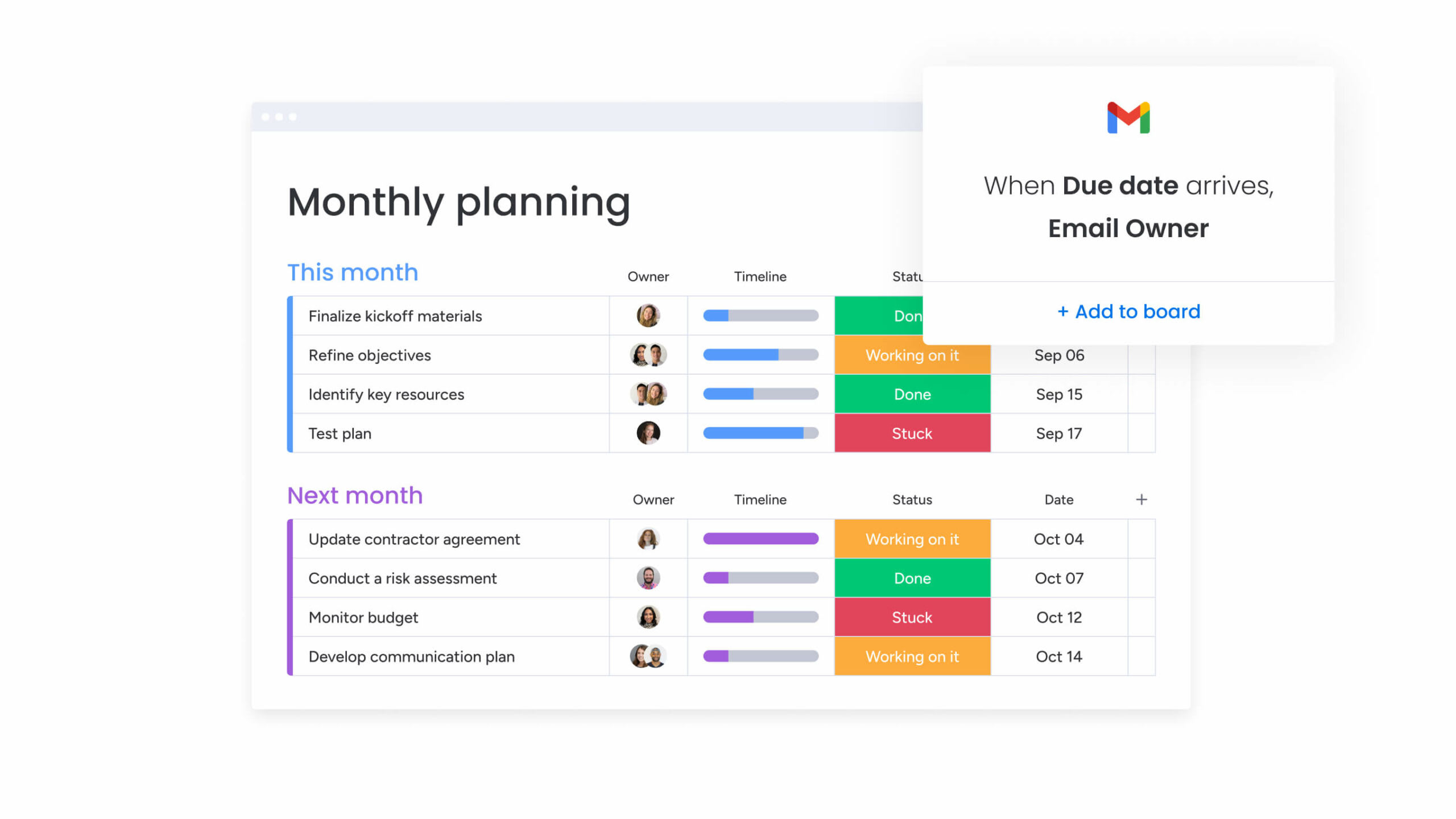
Most users will find setting up and managing their integrations quicker and easier on monday.com.
Top-notch customer support
Although both platforms offer 24/7 support, customers remark that monday.com provides a better service than ClickUp: “The customer support team is top-notch, always responsive and helpful.”
And user feedback suggests that monday.com goes above and beyond. For instance, here’s what CEO Adi Sarid shared on LinkedIn about his experience:
“monday.com just blew my mind. I had an issue with a search (I was trying to “search everything” but filtered within a specific workspace). I was pretty sure that the type of query I was trying was impossible within the current options, but I decided to give it a go and reached out to support. I thought they would add this as a feature request. Indeed, what I tried was not supported, but they provided a functioning workaround. Not only that, but the rep recorded a video (!!) showing how to implement the workaround!”
Overall, monday work management is the best alternative if you want a fully customizable platform that allows you to automate your workflows and focus on your goals.
But don’t just take our word for it — experience it yourself with a free trial and see how it compares to ClickUp or any of the other alternatives.
 Get started
Get started 

